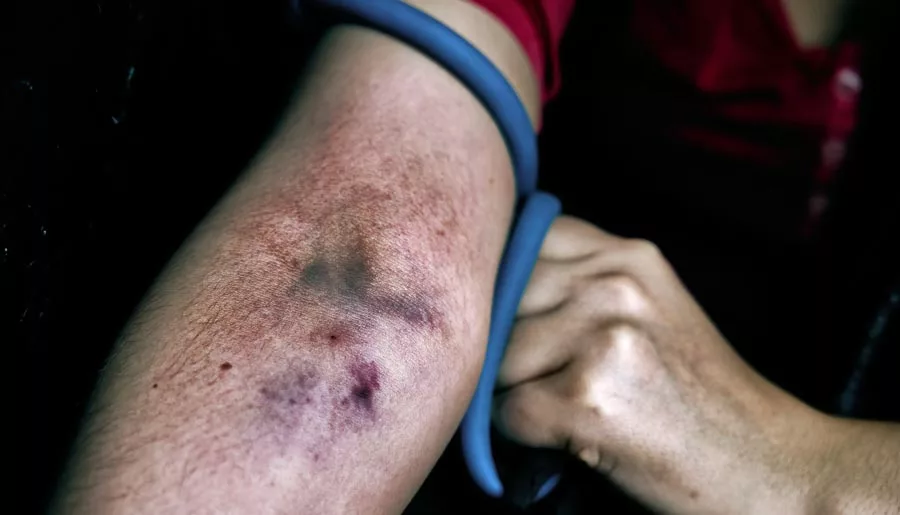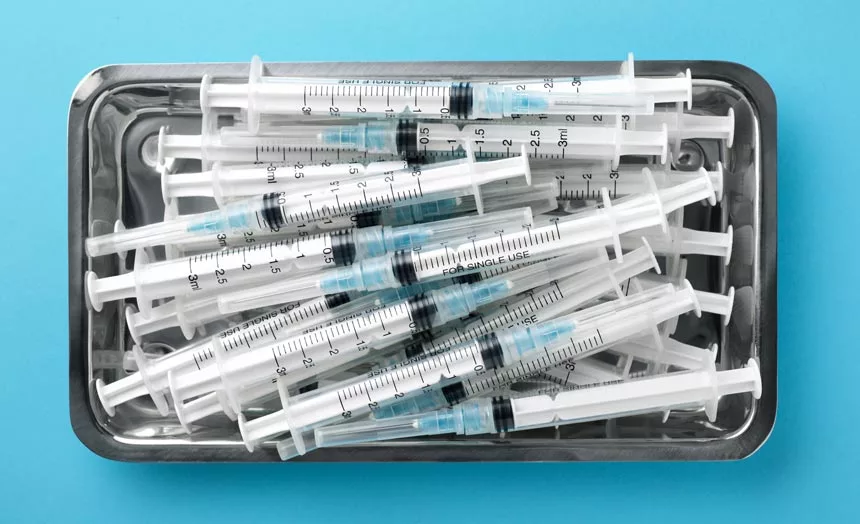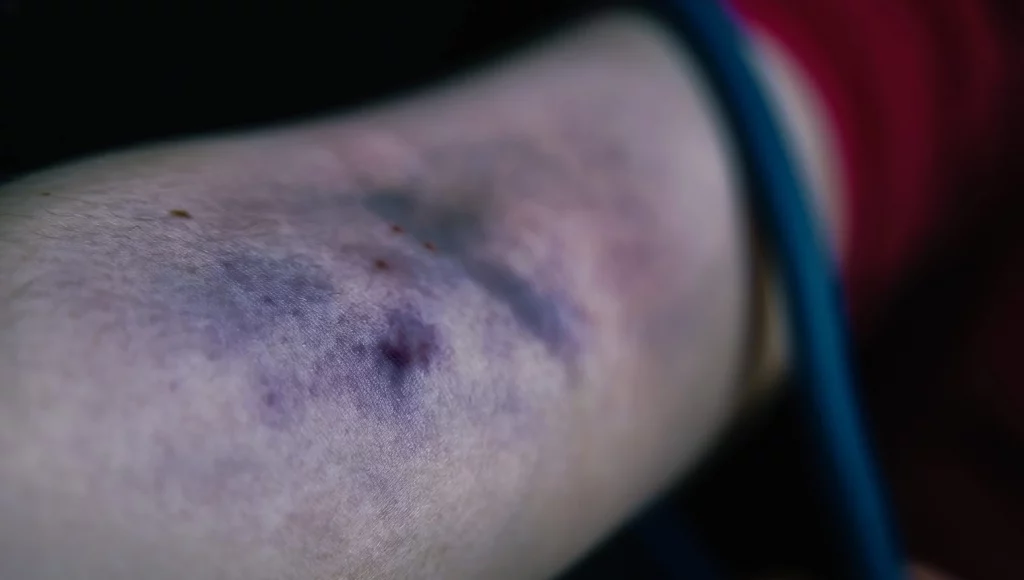What Are Track Marks?
Table of Contents
- What Are Track Marks?
- What Do Track Marks Look Like?
- Understanding IV Drug Use
- Common Drugs Associated With IV Drug Use
- The Dangers of Injecting Drugs
- Recognizing Intravenous Drug Users
- What are the Signs of Drug Overdose?
- Drug Addiction Treatment Options
- Alternative Methods of Battling IV Drug Use
- Find Addiction Treatment Services Near You
There are many methods in which an individual struggling with substance abuse may choose to engage in this behavior. One of these methods is intravenous drug use, in which a person will inject drugs directly into their bloodstream through the use of a syringe.
This injection method can cause users to develop track marks. These are scars that are caused by repeatedly putting needles into a person’s skin. Track marks can be quite dangerous and may cause further damage over time if not properly treated.
Many drugs can be administered via injection. However, this method is particularly common amongst heroin users, as well as those struggling with cocaine and meth addictions.
What Do Track Marks Look Like?

Recognizing what track marks look like can help individuals recognize signs of drug abuse in a loved one. Track marks happen with repeated injection of a drug, and will usually appear on the non-dominant arm of drug users.
The appearance of a track mark can differ based on several factors, including:
- How often someone is injecting drugs
- How much time has passed since intravenous drug use
- The sensitivity of an IV drug users’ skin
- Any underlying health conditions
Someone who has started injection drug use will have track marks that look like small holes or scabs. There may also be some bruising present. As these individuals likely are not injecting drugs everyday, their track marks heal in between uses, which can make them less noticeable.
However, as the addiction progresses, this healing time will gradually begin to decrease. This can result in skin that looks dry or cracked, and may even appear to be infected. This will include irritation, inflammation, and the possible emission of discharge from their track marks.
If someone is consistently developing scar tissue or regularly experiencing skin infections, this is a strong indication of intravenous drug abuse.
Furthermore, the repeated introduction of needles to the same injection site over extended periods of time can result in darkened and raised veins, which will make a track mark more obvious in its appearance.
These repeated returns to the same site will eventually lead to scarring, infection, or the collapsing of these veins. As these become too painful or difficult to access, users will likely switch to a different area to continue using.
Other common injection sites may include other parts of their arm, as well as the veins in the hands, neck, feet, legs, or femoral areas in the thigh. The appearance of track marks in several areas across the body can be a sign of severe addiction.
Understanding IV Drug Use
Most people will not start with IV drug use as, compared to other methods (such as smoking or snorting drugs), this is a particularly intense and dangerous form of substance use.
However, as someone begins to build a tolerance to an abused substance, this can cause them to become desperate to continue experiencing the same high as when they first started using.
At this point, a user turns to injection, as this introduces the drug directly into the bloodstream, resulting in a much faster and much more intense high. Of course, this can also cause several health risks, including an increased possibility of overdose.
Common Drugs Associated With IV Drug Use
There are several drugs that can be taken by injection. As discussed, heroin, cocaine, and methamphetamines are the most commonly associated substances with intravenous drug use.
However, prescription opioids and stimulants may also be used in this way, often producing side effects that can be quite destructive if not properly addressed and treated.
The Dangers of Injecting Drugs
Track marks, while certainly hazardous in themselves, are not the only dangerous side effect associated with injection drug use. There are a number of additional consequences associated with this form of substance use, including:
- Skin infections
- Vein damage (i.e., collapsed veins)
- Blood clots
- Bloodstream infections
- Bloodborne diseases
If someone has a collapsed vein, this can cut off normal blood flow, and as a result, blood clots form. If not treated, a blood clot can result in a heart attack or stroke.
Furthermore, according to the Center for Disease Control and Prevention (CDC), using dull or dirty needles, or participating in needle sharing often results in the spreading of bloodborne diseases and infections.
Recognizing Intravenous Drug Users
There are several signs of IV drug use that can be looked out for when trying to determine if someone is taking drugs via injection. The most obvious being the presence of track marks, which will be particularly noticeable if a drug is repeatedly being injected into the same vein.
Heroin track marks, specifically, may be more prone to the skin popping caused by an underlying infection. Heroin injection may also increase a person’s risk of collapsed veins due to using the same vein repeatedly.
While it can be helpful to identify track marks and other tell-tale signs of this form of drug abuse, a user will likely go to great lengths to hide their behavior. However, this can also be a sign of IV usage in itself.
Wearing more conservative clothes, particularly in appropriate contexts, can be a significant indicator of IV drug use. An intravenous drug user may begin to wear long sleeves, scarves, or baggy clothes more often in an attempt to hide track marks or track mark scars.
In addition to this, increased irritability or mood swings, significant and sudden weight loss, and the sudden development or worsening of mental health conditions may all also indicate an intravenous drug addiction.
What are the Signs of Drug Overdose?
The symptoms of a drug overdose may vary depending on the specific type of drug a person is taking, as different drugs will have different interactions with the body. However, some of the more universal signs of overdose may include:
- Very high or very low body temperatures
- Irregular heart rate
- Irregular breathing
- Loss of consciousness
- Unresponsiveness or confusion
- Seizures
- Heart problems (i.e. heart attack, stroke, etc.)
Drug Addiction Treatment Options
There are several addiction treatment options available for those struggling with substance abuse today. For an IV drug user, this will likely involve medical detox and inpatient treatment services, due to the intensity of the type and method of drug use they are engaging in.
If you are unsure about what type of treatment is best for you or your loved one’s addiction, it may be helpful to speak with an addiction specialist or other healthcare provider to narrow down these options.
Medical Detox
Medically supervised detox programs provide a way for individuals to overcome addiction in a safe and clinical environment. This process will provide constant medical monitoring and support, which can help ease more intense substance withdrawal periods.
For example, with intravenous drug use, a heroin addiction will likely produce extremely uncomfortable withdrawal symptoms and drug cravings. This can not only endanger a recovering individual’s physical and mental safety, but put them at an increased risk of relapse.
Thus, the structure and supervision these programs can provide is essential in ensuring their successful recovery and ability to maintain abstinence.
Inpatient Treatment
Usually the next step in treatment after medical detox, inpatient programs require individuals to live at a treatment facility throughout the duration of their addiction recovery process. This allows them to receive consistent supervision and support as they overcome addiction.
These programs will likely offer a variety of services, including:
- Therapeutic and counseling services
- Nutrition planning
- Holistic treatment approaches
- Stress reduction services
- Vocational training programs
- Social skill training programs
- Relapse prevention services
- Addiction education services
Outpatient Treatment
Outpatient treatment does not require clients to live at a facility and is more flexible than an inpatient or detox program. This may include intensive outpatient and partial hospitalization programs, as well as 12-step recovery services.
This treatment option tends to be more affordable compared to others and is particularly useful for those who cannot take leave from personal duties or work. They can help individuals learn relapse prevention skills, as well as how to independently maintain their sobriety.
Alternative Methods of Battling IV Drug Use
Another method of battling the negative consequences of IV drug use is the Harm Reduction Recovery Model. This refers to certain policies and practices being put in place as a means of minimizing the harm substance abuse can cause, both to the user and the people around them.
This approach recognizes that some individuals, even those with the intention of improving their lives, are not yet ready or able to overcome their addictions. Rather than judging or attempting to control their addiction, harm reduction provides a way for them to use in a safer manner.
Harm reduction programs help minimize the harmful consequences of substance abuse, particularly that which takes place intravenously, in several ways, including:
- Establishing safe consumption spaces
- Creating needle exchange programs
Safe Injection Sites

A safe injection site, also known as a medically supervised injection center, is a legally sanctioned space where people can partake in IV drug use under careful medical supervision.
Contrary to popular belief, these do not encourage this behavior. Rather, they provide a safer means of abusing drugs, which would otherwise take place in far more dangerous conditions. This, of which, can not only endanger the user but those around them, as well.
According to the World Health Organization (WHO), these have been found to have a number of benefits, including the prevention of infectious diseases, provision of addiction treatment referrals and educational resources, and significant decreases in overdose death cases.
Syringe Exchange Programs
Also known as needle exchange programs, these services provide sterile injection equipment, such as needles and syringes. This helps minimize the spread of infectious diseases (i.e., AIDs, Hepatitis B, etc.) as well as a tool for educating individuals on the risks of substance abuse.
These programs also provide several other services, including:
- The distribution of materials that can prevent the spread of infectious diseases, (i.e., alcohol swabs and condoms).
- Distribution of addiction treatment referrals, including those to medication-assisted treatment services (i.e., medically supervised detox programs).
- Provision of referrals to other medical, mental health, legal and/or social services.
- Spreading of addiction education resources and recovery support services.
Find Addiction Treatment Services Near You
If you or a loved one is struggling with substance abuse, particularly if using intravenously, this can have extreme consequences for your physical and mental health. Here at Find Addiction Rehabs, we are dedicated to helping you find the right addiction treatment options for you.
Our hotline is available 24/7 to provide you with recovery support and resources, anytime you need them. So don’t wait; call today, and take that first step to living a drug-free life, where you can become a happier, healthier, and sober you!
Bryan was born in Philadelphia and remains an ardent supporter of Philadelphia sports. After attending FSU and FAU where he majored in writing, Bryan ventured out to follow in the footsteps of his idols, running straight into drug addiction. After being arrested by the President’s Secret Service, Bryan finally started to rebuild his life and beat that monkey off of his back through writing, playing music, and studying Buddhist philosophy.
Despite still having the occasional struggles with mental health, Bryan strives to be a little bit better a person each day. With the support and love from a loyal family, and kind-hearted and generous friends, Bryan tries to help people vanquish their own personal demons as he did and bring more love and beauty into a pessimistic world.

